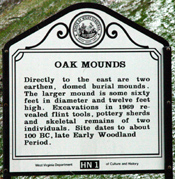
Oak Mounds
Encyclopedia

Mound
A mound is a general term for an artificial heaped pile of earth, gravel, sand, rocks, or debris. The most common use is in reference to natural earthen formation such as hills and mountains, particularly if they appear artificial. The term may also be applied to any rounded area of topographically...
, and a smaller mound to the west. They are located outside Clarksburg
Clarksburg, West Virginia
Clarksburg is a city in and the county seat of Harrison County, West Virginia, United States, in the north-central region of the state. It is the principal city of the Clarksburg, WV Micropolitan Statistical Area...
, in Harrison County, West Virginia
Harrison County, West Virginia
As of the census of 2000, there were 68,652 people, 27,867 households, and 19,088 families residing in the county. The population density was 165 people per square mile . There were 31,112 housing units at an average density of 75 per square mile...
.
Mounds
These mounds have never been totally excavated but they were probably built between 1 and 1000 CE by the Hopewell cultureHopewell culture
The Hopewell tradition is the term used to describe common aspects of the Native American culture that flourished along rivers in the northeastern and midwestern United States from 200 BCE to 500 CE. The Hopewell tradition was not a single culture or society, but a widely dispersed set of related...
mound builders, prehistoric indigenous peoples of eastern North America. The larger mound is about 12 feet high and 60 feet in diameter. A number of burials of important persons of the culture probably occurred in these mounds.
Site
An incorrectly worded historical marker sign is located on County Rt. 98 near the Veterans Administration Hospital. The sign errounously states the direction the mounds are in relative to the sign itself, however the mounds are actually to the west, on the far side of the West Fork River, and not "Directly to the east..." The sign's entire inscription reads: "Oak Mounds - Directly to the east are two earthen, domed burial mounds. The larger mound is some sixty feet in diameter and twelve feet high. Excavations in 1969 revealed flint tools, pottery shards and skeletal remains of two individuals. Site dates to about 100 BC, late Woodland PeriodWoodland period
The Woodland period of North American pre-Columbian cultures was from roughly 1000 BCE to 1000 CE in the eastern part of North America. The term "Woodland Period" was introduced in the 1930s as a generic header for prehistoric sites falling between the Archaic hunter-gatherers and the...
."
See also
- MoundMoundA mound is a general term for an artificial heaped pile of earth, gravel, sand, rocks, or debris. The most common use is in reference to natural earthen formation such as hills and mountains, particularly if they appear artificial. The term may also be applied to any rounded area of topographically...
- Mound builder (people)
- Effigy moundEffigy moundSites in the U.S. of similar history may be found at Indian Mounds ParkAn effigy mound is a raised pile of earth built in the shape of a stylized animal, symbol, religious figure, or human figure. Effigy mounds were only built during the Late Woodland Period .Effigy mounds were constructed in many...
- Earthwork (archaeology)
- TumulusTumulusA tumulus is a mound of earth and stones raised over a grave or graves. Tumuli are also known as barrows, burial mounds, Hügelgrab or kurgans, and can be found throughout much of the world. A tumulus composed largely or entirely of stones is usually referred to as a cairn...
- burial mound - List of Hopewell sites

